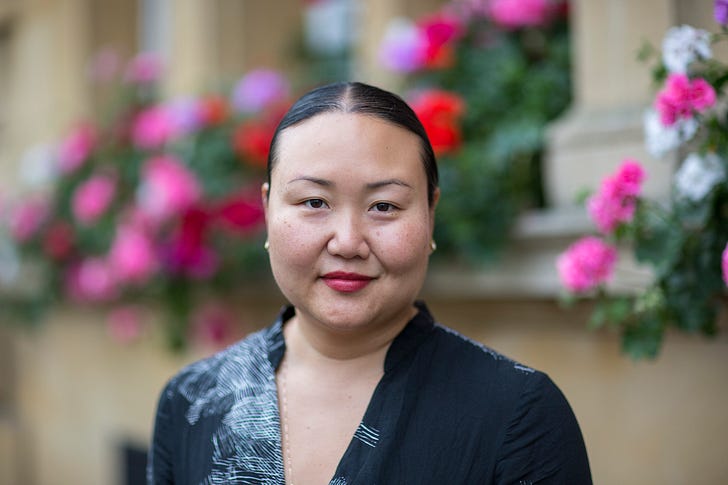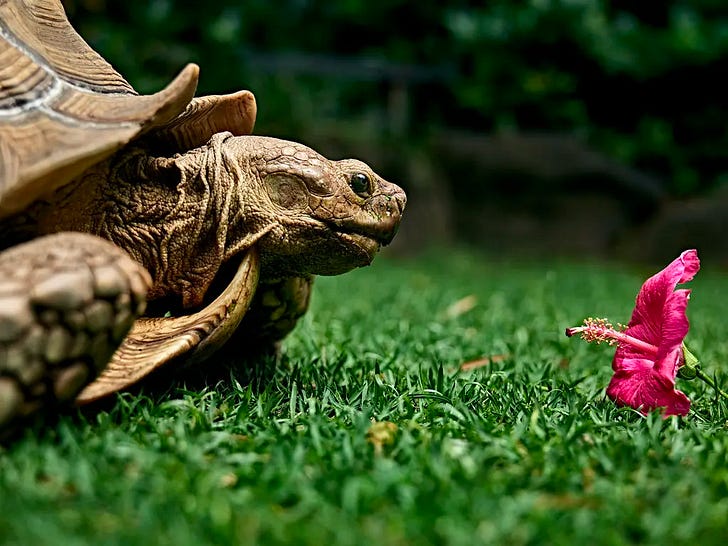Art Dogs is a weekly dispatch introducing the pets—dogs, yes!, but also cats, lizards, marmosets, and more—that were kept by our favorite artists. Subscribe to receive these weekly posts to your email inbox.

Hanya Yanagihara is a magazine journalist, the author of “A Little Life,” which was shortlisted for the Man Booker Prize, and the acting editor of The New York Times’ T Magazine.
When people talk about Hanya’s life, they often note its unique trajectory. She was born to a Hawaiian doctor and a Korean-born Hawaiian potter, making Hanya a fourth generation Hawaiian. The family was peripatetic, following her father’s work to Los Angeles, Baltimore, New York, Irvine, California, Tyler, Texas, and Honolulu, which the author considers home. (Her parents live three blocks from the house Barack Obama grew up in.)
After graduating from Punahou High School, Hanya went to Smith College in Massachusetts, an experience she described as “awful.” She moved to Manhattan and began working as a book publicist, then a magazine editor, all the while using her off-hours to write her first novel, The People in the Trees. It took Hanya 18 years to finish this first book. She was 38 years old when it went to publish.1
After spending almost two decades writing that first novel, she managed to produce her next book, A Little Life, in just 18 months. This book would change her life. As Refinery29 wrote: “Thanks to word of mouth, [A Little Life] unexpectedly became a globally acclaimed bestseller, a literary phenomenon seen on hundreds of thousands of beach towels, nightstands, and subway cars since its debut in 2015.”
When asked how it felt to write A Little Life, Hanya gave an answer I feel obliged to share: “at its best, it felt like surfing (a sport I can’t do, by the way)—like I’d caught a long, steady wave and was riding it for hours. It was tiring but exhilarating, too.”2

Hanya’s upbringing in Hawaii, and her parents’ influence on her, show up in any profile you’ll read about the brainy, mysterious icon. She told Emma Brokes: “I always say that for Asian Americans, Hawaii is the imaginary homeland. It’s the closest thing that Asian Americans have to Harlem, the place where everything about the culture at large feels familiar, or invented by you. It’s where I consider home even after all these years in New York.”
She often reflects on her home state and family life in her own essays, including one of my favorites from 2017: A Pet Tortoise Who Will Outlive Us All. In the beautiful essay—which you should read!—Hanya describes her experience meeting Fred, an 85-pound sulcata tortoise that her parents adopted. Fred was “an impulse purchase ($250, from a man living a few minutes drive away, near Waikiki) whose consequences — as with all impulse purchases — were not quite fully imagined,” Hanya explains.



In reflecting upon Fred and her parents’ relationship, Hanya manages to address such fundamental themes as childhood and parenthood, love, aging, and mortality.
I love this passage:
To be in the company of a tortoise is to be reminded — instantly, inarticulably — of the oldness of the world and the newness of us (humans, specifically, but also mammals in general). Nature has created thousands of creatures, but most of us have been redrawn over the millenniums: Our heads have grown larger, our teeth smaller, our legs longer, our jaws weaker. But tortoises, some varieties of which are 300 million years old, older than the dinosaurs, are a rough draft that was never refined, because they never needed to be. They are proof of nature’s genius and of our own imperfection, our fragility and brevity in a world that existed long before us and will exist long after we’re gone. They are older than we are in all ways, as a tribe and as individuals — they can live 150 years (and can grow to be 200 pounds). As such, you cannot help feeling a sort of humility around them: They may be slow and ungainly and lumpily fashioned, but they are, in their durability and unchangeability, perfect in a way we aren’t. It is all this that makes them unique and unsettling animals to live with, for to be around them is to be reminded, incessantly, of our own vulnerability — and our own imminent deaths.
And this one:
Much as the role of a child has changed in the past century — from undersize workers to creatures to spoil and cherish — so, too, have the animals in our lives come to fulfill a certain need. Many of us in the developed world have easier lives than our forebears had: There is less arduous labor; there is less labor in general. But it can often feel that the luxury of time has been accompanied by a heightened, commensurate craving for love: Part of the modern condition is wondering who might love us and how that love might be more perfectly expressed, and animals’ new duty is to answer both of those problems, to make this loneliest of ages feel a little less lonely.

Hanya’s parents purchased 15-year-old Fred when they were 71 and 69, and Hanya was 42. Thus, their pet tortoise will likely outlive all of them. (“As the days passed, I couldn’t help seeing him as a late-in-life yank of the parental tether,” Hanya writes.) During her visit home, she makes clear that neither her nor her brother would adopt Fred when her parents pass, news that her parents receive surprisingly well. Upon returning to New York, her parents keep Hanya abreast of Fred’s life through text messages, which stir the great writer’s mind:
Sometimes, after reading these messages, I found myself slipping into a daydream, imagining Fred’s life — and, by extension, my own — years into the future. I imagined a day in which my parents were dead and still no one had determined what to do with Fred: where he would live, who would talk to him. I imagined Fred edging out of his wooden house to find something to eat, a young specimen of an old species on a young island in an old world. I imagined him sitting, and waiting, for someone to come feed him. And when no one did? Maybe he would start eating the grass. And then when the grass was gone, he might eat the petals from the shower trees. And then the ferns. And then the ti leaves. And then the gardenia bushes. He would eat and eat, and when the yard had been denuded of anything green, he would wait until the lawn turned green once more. A tortoise knows how to wait. It is another piece of wisdom that comes from being a member of a species that is so very old.


I read this essay about Fred in an article club with a few friends during the pandemic. In the course of our discussion, someone shared an astounding fact: one of Darwin’s pet tortoises, Harriet, had only died recently.
Harriet was reputed to have been one of three tortoises taken from the Galapagos Islands by Darwin on his 1835 voyage aboard the HMS Beagle.3 According to the legend, Harriet was “just 5 and probably no bigger than a dinner plate when she was taken from the Galapagos to Britain.” (Like Fred, Harriet’s favorite food was hibiscus flowers.) She spent a few years in Britain before being moved to Australia in the mid-1800s. At the time of her death in 2006, from heart failure, she lived at an Australian Zoo that was owned by Steve Irwin (yes, “The Crocodile Hunter”).
Harriet is one of the “longest-lived known tortoises,” behind Tu'i Malila, who died in 1966 at the age of 188 or 189; Jonathan, who remains alive at an age of 190, and the mysterious Adwaita, who died in 2006 at an estimated age of between 150 and 255 years.
Learning about Harriet—about how Darwin’s tortoise came to be owned by The Crocodile Hunter and got to circumnavigate the globe multiple times in the 19th century—it made me think that perhaps Hanya’s dream of Fred spending his final years as a perpetual lawn mower in her parent’s backyard was actually quite a limiting vision for his one little life. Who knows what great author will own Fred next, or where in the world he might end up?
Maybe Fred’s best years are ahead of him.
Maybe yours are, too.

Art Dogs is a weekly dispatch introducing the pets—dogs, yes!, but also cats, lizards, marmosets, and more—that were kept by our favorite artists. Subscribe to receive these weekly posts to your email inbox.
Special thank you to
for sharing this essay by Hanya Yanagiharia with me in 2020.https://www.refinery29.com/en-us/hanya-yanagiharia-a-little-life-unstyle
https://lithub.com/writing-a-memoir-to-honor-my-younger-self/
https://www.latimes.com/archives/la-xpm-2006-jun-25-fg-harriet25-story.html#:~:text=A%20176%2Dyear%2Dold%20tortoise,has%20died%20of%20heart%20failure.





Loved reading about Fred. We have a 16-year old Sulcata Tortoise who currently weighs in about 60 pounds. My husband and I are 72 and 79--and we wonder, too, about our beloved Darwin’s future. He was the size of a 50 cent piece when we impulsively made the decision to bring him home. We definitely weren’t considering the future! 🤷
We have a 70-80 year old giant tortoise living next door and one of my dogs is completely smitten. They lie next to one another and gaze lovingly at one another through a hole he ate in the fence (my dog Mikey did it...not the tortoise).
I’ve scolded him for falling for a much older female. 🤷🏻♂️